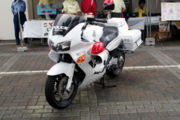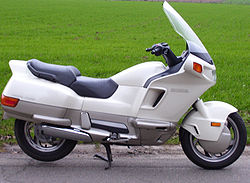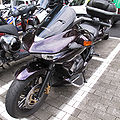 | |
| Manufacturer | Honda Racing Corporation |
|---|---|
| Production | 2006-present |
| Predecessor | Honda RC211V |
| Engine | 800 cc (49 cu in) four-stroke V4 |
| Related | Honda CBR600RR Honda CBR1000RR |
The Honda RC212V is a road racing motorcycle developed to race in the 800 cc (49 cu in) MotoGP series. Officially introduced on 30 October, 2006 as the RC211V replacement in the MotoGP series, it was developed by Honda Racing Corporation (HRC) throughout 2006 and began officially racing in the 2007 season.
The model name designates the following:
- RC= Honda's traditional racing prefix
- 212= second works bike of the 21st century
- V= V engine
The RC212V features an 800 cc (49 cu in) liquid-cooled four-stroke DOHC 4-valve V4 to power the all new chassis built with mass centralization and handling as top priority.
2007
Dani Pedrosa and Nicky Hayden rode the factory-backed versions, while the customer machines were ridden by Marco Melandri, Toni Elías, Carlos Checa, and Shinya Nakano. A perennial issue with Honda's GP motorcycle is which team and rider receives the best parts and whether performance differences are due to the rider not the machine. Before the racing season started in 2007, Melandri was quoted as saying, "In the past few tests I've seen a big progression with Pedrosa's bike, but we're still waiting for new parts from Honda."
After a few rounds, Honda riders did not achieve the results expected, leading HRC chief Satoru Horiike to admit that they made a mistake in the motorcycle's development. Melandri decided to ride with the Ducati team in 2008 and Pedrosa's dissatisfaction led to rumors that he was leaving Honda. Towards the end of 2007, however, there were signs of improvement, with the Repsol Honda team taking the last five pole positions of the season and Pedrosa winning the last round at Valencia.
2008
For 2008, HRC planned to use pneumatic valve springs and an all-new chassis. The mass centralization of the 2007 model was thought to have gone too far, and instead the 2008 model is more open, reducing heat and improving balance. The factory team riders are Pedrosa (through 2009) and Hayden (through 2008). Satellite team riders are Nakano, Andrea Dovizioso, Randy de Puniet and Alex de Angelis.
The 2008 pneumatic valve version has only been available to the Repsol Honda team, and in pre-season testing it has been highly problematic. The original intent of running an all-new engine and chassis was shelved when the engine did not perform to expectations. Pedrosa and Hayden then tested a 2007 engine in a 2008 chassis, and after still being near the bottom of testing timesheets, the Repsol Honda team used the 2007 version in the first round’s practice for comparison purposes. For the race, Pedrosa chose a revised 2008 chassis while Hayden chose the 2007. The pneumatic engine was race-debuted by Hayden at the Donington round, and he was charged with developing the new engine for the rest of the season (Pedrosa deciding to continue using the conventional valve engine). An electronic problem at the subsequent Assen round caused Hayden to run out of fuel just before the line, allowing Colin Edwards to come around him and take the remaining podium position.
At the 13th round it was announced that Pedrosa would switch to Bridgestone tires for the remainder of the season, and he also planned to start racing the pneumatic valved engine in the 14th round at Indianapolis.
Unlike the other Honda teams, de Puniet's Team LCR used Öhlins suspension instead of Showa.
2009
For 2009, the factory team riders will be Pedrosa and Dovizioso, and the satellite team riders will be Elías, De Angelis, de Puniet and Yuki Takahashi; Elías will be given a factory spec machine.The 2009 model will be largely the same as the 2008. All 6 of the RC212Vs will use pneumatic valve engines.
After two rounds the Repsol Honda riders had only achieved a single podium. Vice president of HRC, Shuhei Nakamoto, said "If Dani does not win the world championship it is Honda’s responsibility, not Dani’s,"[ while Pedrosa said "I’ve spoken to (Nakamoto) but I’ve spoken to many people like him, but it seems like it’s three years of the same story. What I really need is to see is some things coming, not always just hearing, talking, or a meeting. I’d like to have something where I can say okay, thank you, this is good."
Before Round 6 at Catalunya, Dovizioso expressed frustration that Pedrosa would be given priority in the post-race test, feeling that the Spaniard's poor physical condition would not lead to a productive evaluation. In the race, Dovizioso finished in 4th place and Pedrosa in 6th, and Pedrosa announced he would skip the test to rest. Using the new chassis, Dovizioso was top rider of the test.
In practice at Round 7 at Assen Pedrosa remarked that the new chassis was an improvement in braking and stability, but both Pedrosa and Dovizioso crashed in the race at the same turn. At the following round at Laguna Seca, Pedrosa won the race, while Dovizioso crashed out.
In post-race testing at Brno, the Repsol team tested Öhlins suspension components, which until then had been using Showa. For the San Marino round, Dovizioso will use Öhlins and Pedrosa will use Showa suspension.
The 2009 season ended with 3 wins for the Repsol Honda team -- 2 for Pedrosa and 1 for Dovizioso -- and a 2nd place in the constructor championship for Honda. At post-race testing at Valencia, Pedrosa tested Öhlins suspension exclusively, and the factory team tried a new chassis and swingarm. Pedrosa and Dovizioso had the 3rd and 6th fastest times over the 3-day test.
| Nicky Hayden testing the RC212V. | Dani Pedrosa testing the RC212V. |
Specifications
| 2007 | 2008 | 2009 | ||
|---|---|---|---|---|
| Overall length | 2,050 mm (80.7 in) | 2,060 mm (81.1 in) | ||
| Overall width | 645 mm (25.4 in) | |||
| Overall height | 1,125 mm (44.3 in) | |||
| Wheelbase | 1,440 mm (56.7 in) | 1,450 mm (57.1 in) | ||
| Road Clearance | 125 mm (4.9 in) | |||
| Weight | over 148 kg (326 lb) | |||
| Engine Type | Liquid-cooled, Four-stroke, DOHC 4 Valve, V-4 | |||
| Displacement | 800 cc (49 cu in) | |||
| Max Power | Over 210 PS (207 hp) | |||
| Frame Type | Twin-tube | |||
| Tire Size | ||||
| Front | 16 in (41 cm) | 16.5 in (42 cm) | ||
| Tires | Michelin | Michelin, Bridgestone | Bridgestone | |
| Rear | 16.5 in (42 cm) | |||
| Suspension | ||||
| Front | Telescopic | |||
| Suspension | Showa SPL | Showa SPL, Öhlins | ||
| Rear | New Unit Pro-link | Pro-link | ||
| Fuel Capacity | 21 L (6 US gal) | |||
























